Highlights of Airshow China 2024
November 14, 2024
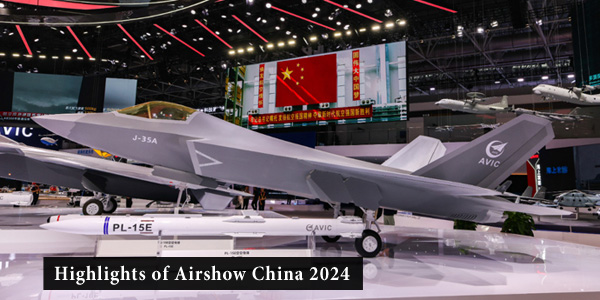
The 2024 China International Aviation and Aerospace Exhibition in Zhuhai, Guangdong Province, has brought together over 1,000 exhibitors from 47 countries, making it China’s largest airshow.
Chinese companies showcased a range of groundbreaking technological innovations, including flying cars, advanced cargo planes, spacecraft, and next-generation military fighter jets. The event highlighted China’s significant strides in aerospace and aviation.
The event primarily focused on showcasing China’s advancing military technology and highlighted the country’s ambitions to solidify its position as a global leader in aerospace and military manufacturing while bolstering its economic partnerships. Here is an in-depth look at the show’s prominent military showcases, the strategic agreements signed, and the event’s projected economic and geopolitical impact.
Stealth Fighters and Drones
The Zhuhai Air Show displayed some of China’s most advanced stealth aircraft, including the J-35A and J-20 fighters. The J-35A, a fifth-generation carrier-based stealth fighter, is designed for advanced combat operations and marks a significant step in China’s naval aviation capabilities.
Originally, the J-35A was intended for export, before evolving into a carrier-capable model for the PLA Navy’s growing aircraft carrier fleet. However, the People’s Liberation Army Air Force (PLAAF) has shown renewed interest in adopting a land-based version of the jet.
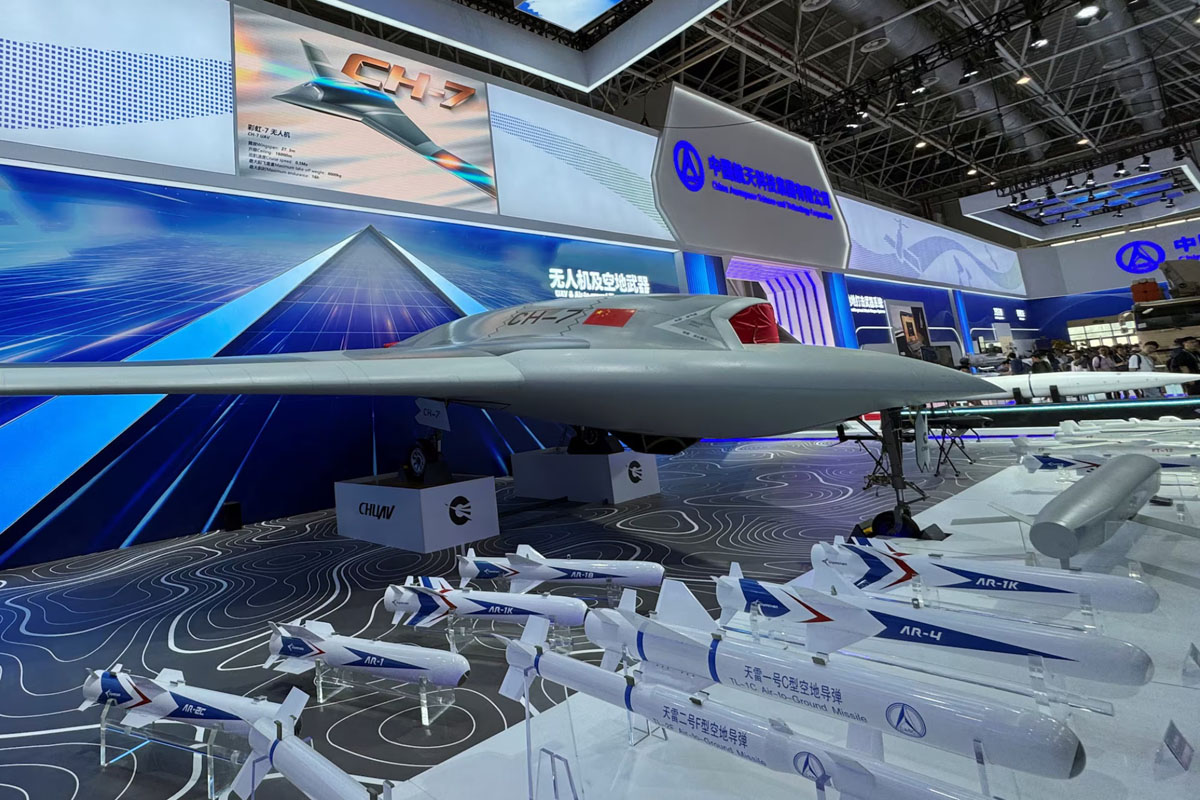 A model of CH-7 stealthy unmanned aircraft is displayed alongside mockups of air-to-ground missiles at the China International Aviation and Aerospace Exhibition, or Airshow China, in Zhuhai, Guangdong province, China November 13, 2024. (Image Credit: Reuters/Sophie Yu)
A model of CH-7 stealthy unmanned aircraft is displayed alongside mockups of air-to-ground missiles at the China International Aviation and Aerospace Exhibition, or Airshow China, in Zhuhai, Guangdong province, China November 13, 2024. (Image Credit: Reuters/Sophie Yu)
Alongside it J-35A, the larger J-20 stealth fighter was also showcased, demonstrating its advanced air-combat capabilities, positioning it as a rival to the U.S. F-35. The stealth drone CH-7, noted for its maritime surveillance capabilities, also made an appearance.
Experts believe the CH-7 can support strategic ISR (intelligence, surveillance, and reconnaissance) operations, such as monitoring U.S. naval activities and tracking aircraft carriers.
China’s Wing Loong-X drone was also on display. Developed by AVIC, this medium-altitude, long-endurance drone features cutting-edge technology and boasts a large payload capacity with a range of combat-ready equipment, including sonar buoy pods, torpedoes, and anti-ship missiles. With recent test flights underway, the Wing Loong-X stands at the forefront of China’s unmanned aerial system innovations.
World’s Largest Uncrewed Ship
The JARI-USV-A “Orca,” developed by China, is a cutting-edge large unmanned combat vessel with a unique trimaran hull, equipped with advanced features like a Vertical Launch System (VLS) for missiles, a rear helipad for UAVs, and a specialized integrated mast with multiple radar arrays.
Notable for its size, it displaces 420 tons and measures 58 meters in length, making it the largest combat USV globally, much larger than comparable U.S. unmanned surface vessels. The Orca’s design prioritizes stealth, featuring radar-resistant technology that enhances survivability in high-risk zones. Capable of speeds up to 40 knots and a range exceeding 4,000 nautical miles, it is optimized for extended missions as a forward defense vessel or “picket ship.”
In addition to its VLS, the Orca houses an advanced “S-band + X-band” AESA radar, along with infrared and electro-optical sensors for superior situational awareness and multi-role functionality, covering anti-ship, anti-air, and anti-submarine warfare. It also includes a platform for UAV operations and options for sonar arrays, broadening its surveillance and strike capabilities.CSSC ‘JARI-USV-A’ USV “Orca”to Debut in China Zhuhai Airshow | Length - 58m, Beam Width - 23m, & Displacement - 500t pic.twitter.com/hGEYk4H4mB
— David Wang (@Nickatgreat1220) November 9, 2024
Demonstrated at the Zhuhai Airshow, the Orca underscores CSSC’s ambitions for export, particularly in defense markets focused on unmanned, modular, and stealth-enabled platforms, positioning it as a versatile player in modern naval strategy.
Air Defense Systems
The Hongqi-19 (HQ-19) missile defense system captured significant attention among the ground-based displays. This system is engineered to intercept both conventional ballistic missiles and advanced hypersonic glide vehicles, like the U.S. THAAD system.
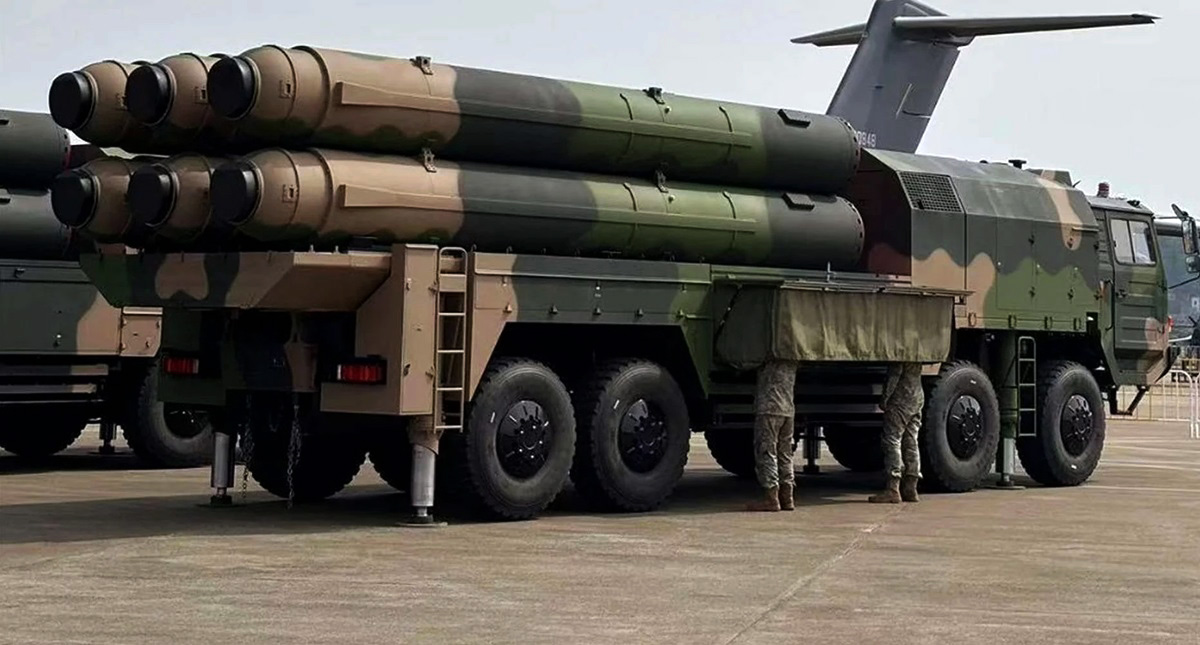 China’s Hongqi-19 (HQ-19) ballistic missile defense system. (Image Credit: X/David Wang)
China’s Hongqi-19 (HQ-19) ballistic missile defense system. (Image Credit: X/David Wang)
It represents a critical component in China’s national defense strategy, aiming to counter threats from stealth technology and hypersonic warfare. Also on display was the YLC-2E radar system, a modern air-defense radar system capable of tracking stealth targets, underscoring China’s enhanced focus on strengthening its aerial surveillance capabilities.
China South Industries Group Corporation (CSGC) and Norinco showcased their truck-mounted microwave system on an 8×8 light armored chassis, designed to counter drones, underscoring China’s advancements in microwave and laser weapon technology for global defense markets.
Cargo Space Shuttle
China also introduced its first cargo space shuttle, named the Haolong. According to the chief designer, the Haolong has now progressed to the engineering development phase, signaling that it may soon make its public debut.
One of the shuttle’s most notable features is its design for streamlined, aircraft-style maintenance after landing, allowing it to undertake multiple missions. This reusability factor is expected to significantly cut down the shuttle’s total lifecycle costs, according to the designer.
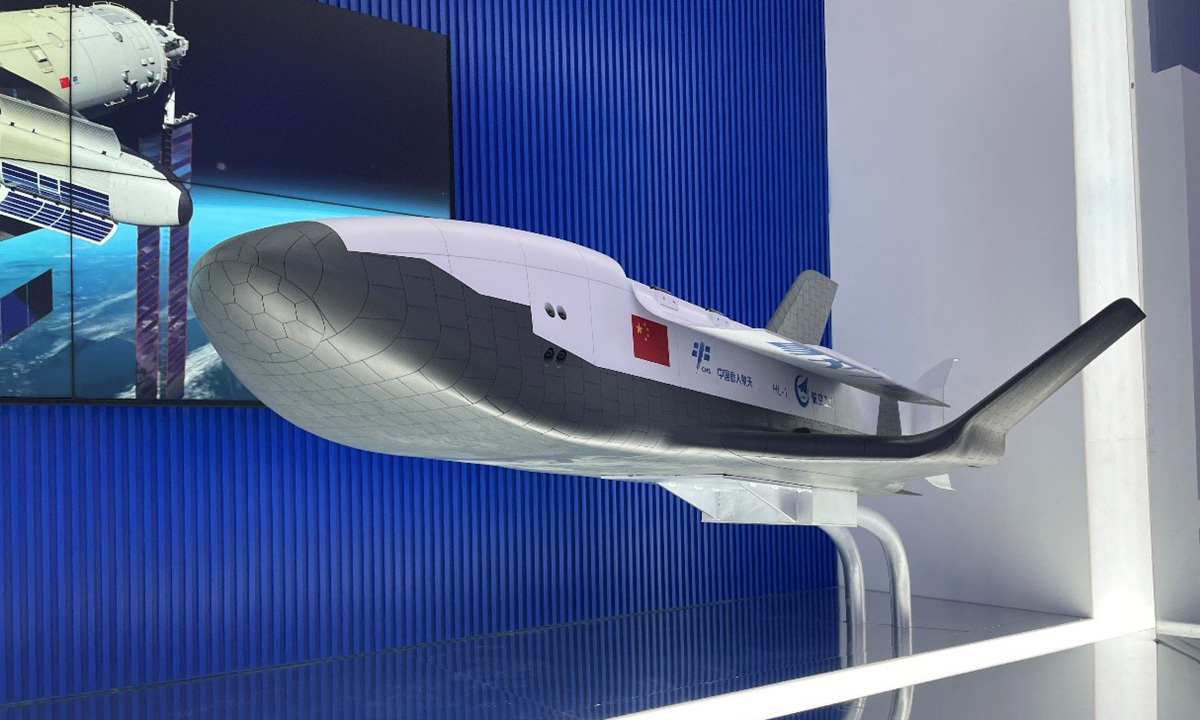 The model of a Haolong spacecraft is on display at the exhibition hall of the Aviation Industry Corporation of China at the Airshow China 2024 in Zhuhai, South China’s Guangdong Province from November 12 to 17, 2024. (Image Credit: Liu Xuanzun/GT)
The model of a Haolong spacecraft is on display at the exhibition hall of the Aviation Industry Corporation of China at the Airshow China 2024 in Zhuhai, South China’s Guangdong Province from November 12 to 17, 2024. (Image Credit: Liu Xuanzun/GT)Commercial Aviation and Flying Cars
Aero Engine Corporation of China (AECC) debuted 67 products, with nearly half of them showcased for the first time. AECC also unveiled China’s first domestically developed AEF1200 large engine. This new engine is designed to power future models of large transport aircraft, reinforcing China’s focus on self-reliance in high-tech aviation components, a move expected to bolster its global presence in aerospace manufacturing.
Meanwhile, the Commercial Aircraft Corporation of China (COMAC) made headlines with announcements that underscore China’s ambitions in the large aircraft sector. Air China became the first confirmed customer for COMAC’s upcoming C929 widebody jet, a twin-aisle aircraft aiming to rival Boeing’s 787 and Airbus’s A350.
Additionally, Hainan Airlines ordered 60 C919 narrowbody jets and 40 C909 regional jets, while Guizhou Airlines signed a deal for 30 C909s. With the C929 targeting long-haul routes of up to 12,000 kilometers and plans for a prototype test flight “soon,” COMAC and other players are fast-tracking their efforts to enter the global market. These developments at Airshow China underscore how China’s aviation industry is evolving with ambitious goals to become a global leader in commercial aerospace and new air mobility technologies.
In addition to excelling in engine and commercial aviation technology, Chinese companies are pushing boundaries with cutting-edge innovations in the electric and autonomous vehicle sectors. One of the highlights of the air show was the public flight of the “Land Aircraft Carrier,” a flying car developed by Chinese EV manufacturer XPENG. This aerial vehicle demonstrated its capabilities with low-altitude flight.Don’t blink! Here’s how to drive a flying car.#XPENGAEROHT #FlyingCar #LandAircraftCarrier #AirshowChina pic.twitter.com/lK3nTUJ6VD
— XPENG AEROHT (@XPENG_AEROHT) November 12, 2024
Agreements and International Collaborations
The Zhuhai Airshow served as a critical platform for establishing and deepening international economic partnerships. Brazilian aircraft manufacturer Embraer expressed intentions to strengthen its Chinese supply chain, driven in part by growing regional demand for mid-sized aircraft. This focus aligns with China’s broader strategy to expand its aerospace industry and supply chain to rival Boeing and Airbus, aiming to establish itself as a manufacturing hub for aviation parts and systems.
Additionally, the show facilitated dialogue with major international defense contractors, and military firms from Russia, Saudi Arabia, and Italy showcased their wares, promoting cross-country defense partnerships.
The presence of Russia, which demonstrated its latest Su-57 fighter, emphasized the strong defense cooperation between the two nations, potentially expanding China’s access to Russian defense technologies in return for economic partnerships. These collaborations are expected to strengthen China’s defense industry through technology transfers and joint ventures, bolstering the nation’s capability to produce advanced military equipment domestically.Stealth fighter jets from #China and #Russia stage performance during Airshow China in Zhuhai. pic.twitter.com/8DQ52bgIll
— China Daily (@ChinaDaily) November 13, 2024
China’s prominence in military aviation manufacturing has grown significantly in recent years, with investments in stealth technology, hypersonic weaponry, and counter-drone systems. The Zhuhai Airshow reflects the country’s rising prowess, signaling a shift in the balance of aerospace power toward Asia. This display of technology serves not only as a deterrent to regional adversaries but also as a declaration of China’s aspirations to lead the global defense industry.
China’s pursuit of aerospace dominance is also evidenced in its commitment to self-sufficiency in manufacturing aircraft components. The agreements signed with global aerospace partners during the airshow are expected to bring considerable economic gains, particularly in terms of manufacturing infrastructure and supply chain expansion. This approach not only strengthens China’s economy but also secures its place as a formidable competitor to Western aerospace giants, furthering the country’s global standing in military technology and manufacturing.
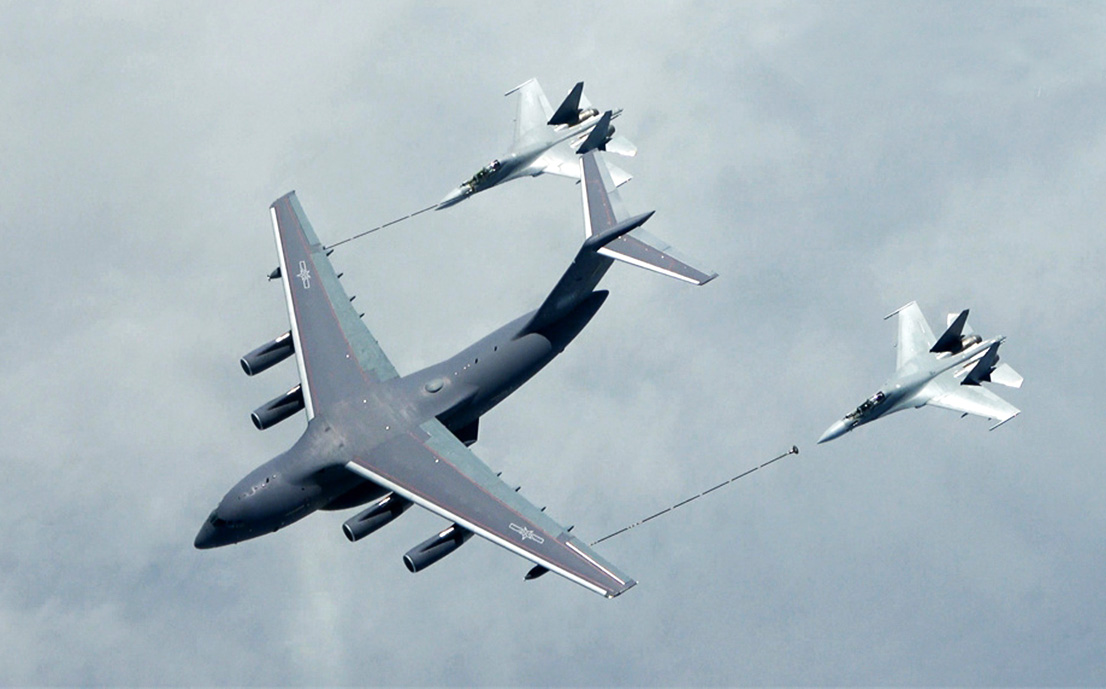 A YY-20 tanker attached to an aviation brigade under the PLA Air Force refuels two J-16 fighter jets during an aerial refueling training exercise. (Image Credit: China Military/Zhan Peng/via GT)
A YY-20 tanker attached to an aviation brigade under the PLA Air Force refuels two J-16 fighter jets during an aerial refueling training exercise. (Image Credit: China Military/Zhan Peng/via GT)ALSO READ:
REGIONS
ISSUES

















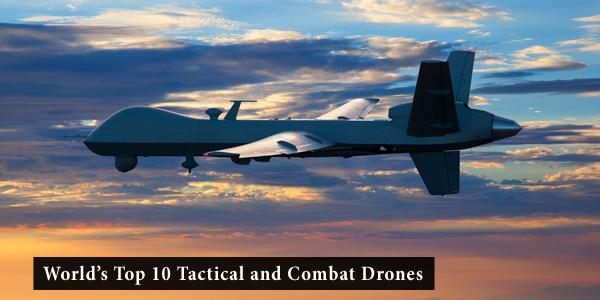 World’s Top 10 Tactical and Combat Drones
World’s Top 10 Tactical and Combat Drones China's Ambitions at Sea and Naval Modernization
China's Ambitions at Sea and Naval Modernization Top 10 Military Tech and Robotics Companies in the World
Top 10 Military Tech and Robotics Companies in the World U.S. Integrating Advanced Robotic and Autonomous Weapon Systems into Army Units
U.S. Integrating Advanced Robotic and Autonomous Weapon Systems into Army Units







